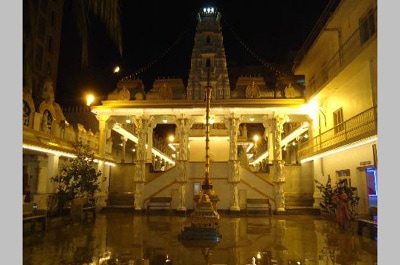Mahatma Gandhi Road |
Mahatma Gandhi Road also known as M.G. Road is a road in Bengaluru, India. It runs east from Trinity Circle at one end to Anil Kumble circle at the other. Known as South Parade in pre-independence era, it was renamed as Mahatma Gandhi Road on 26 February 1948. M. G. Road is also one of the busiest roads in the city and is lined on one side with retail stores, food outlets and restaurants. It has many office buildings, shops and Theaters. It is also a home to a large number of buildings and banks. There are two Metro stations on M. G. Road, the eponymous station and Trinity. Presently, the M.G Road Boulevard is being reconstructed after construction of the MG Road Metro station was completed and services launched on October 20, 2011. The Bangalore Metro line that runs through MG Road, connects the eastern part of Bengaluru with the west.
|
Infant Jesus Strain |
Infant Jesus Church is a Roman Catholic church in Bangalore. Established in 1971, in Vivek Nagar area of Bangalore, the church is dedicated to Infant Jesus. It is known as the Infant Jesus Shrine and was built to commemorate the historic Infant Jesus of Prague; since then numerous miracles have been attributed to the shrine leading to its increasing popularity. A new church building adjacent to the old building was added in 2005.The foundation of the Infant Jesus Church was laid on April 18, 1969, by Rev Duraisamy Simon Lourdusamy, the then Archbishop of Bangalore. Thereafter, in May 1971, Rev. Fr. L. Peter after being appointed the first parish priest, brought the statue of Infant Jesus from Sacred Heart Church, Bangalore and started a tent church at the site. The congregation continued thus for the next eight years, and finally the church building was inaugurated on June 29, 1979, by Rev. Dr. D. S. Lourduswamy, who had then become Secretary of the Congregation for the Evangelization of Peoples in Rome.
|
Sankey Tank |
Sankey tank (Kannada:ಸ್ಯಾಂಕಿ ಕೆರೆ), a manmade lake or tank, is situated in the western part of Bangalore in the middle of the suburbs of Malleshwaram, Vyalikaval and Sadashiva Nagar. The lake covers an area of about 15 ha (37.1 acres). At its widest, the tank has a width of 800 m (2,624.7 ft). Sankey tank was constructed by Col. Richard Hieram Sankey (RE) of the Madras Sappers Regiment, in 1882, to meet the water supply demands of Bangalore. The tank was also known as Gandhadhakotikere, as the Government Sandalwood Depot used to be located near the lake. Sankey reservoir was constructed in 1882 and the works cost Rupees 575000. It was linked to the Miller's tank and Dharmambudhi tank and was built as a safeguard against water shortages, such as that experienced in the Great Famine of 1876–78. The quality of water was not very good and when Lord Connemara, Governor of Madras visited in July 1888 it was commented upon by a local wit: "The men who are thrown off their horses and killed on the spot at Bangalore are the only ones that are allowed by doctors not to have died from drinking bad water.
|
Gavi Gangadareshwara |
Gavi Gangadhareshwara Temple also Gavipuram Cave Temple, an example of Indian rock-cut architecture, is located in Bangalore in the state of Karnataka in India. The temple is famous for its mysterious stone discs in the forecourt and the exact planning allowing the sun to shine on shrine in certain time of the year. It was built in the 16th-century by Kempe Gowda I, the founder of the city. This cave temple dedicated to Shiva in Bengaluru is a well visited temple. Built in the 16th century AD by Kempe Gowda, the founder of Bengaluru, Temple Gavi Gangadhareshwara is an architectural marvel that attracts the faithful by the hordes. One of the oldest temples in Bengaluru, Gavi Gangadhareshwara temple was built by Kempe Gowda in recognition after being released from prison of five years by Rama Raya. There are other idols inside idol Agnimurthi including having two heads, seven hands and three legs. Those who worship this deity believe will cure one of the defects of the eye. The temple is also known for its four monolithic pillars, representing Damaru, Trishul and two fans on the patio.
|
Suryanarayana Temple |
Suryanarayana Temple is located in Domlur on old airport road in the heart of the city. Dedicated to the Sun God, it is one of the most prominent temples in the world dedicated to Lord Suryanarayana.
Built in typical Chola architecture in granite with a huge tower covered with various colourful figures, the Suryanarayana Temple was built by Shri Patel D. R. Krishna Reddy in 1995. The idol of Suryanarayana is 3.25 feet in height and was brought from the Badrinath Temple along with an ornate arch. Below the deity, the idols of Kashyapa and Aditi are placed. Other idols seen are Brahma, Vaishnavi, Nagaraja, Ugranarasimha, Saraswati, Panchamukhi Ganesha and reclining Adi Sheshasayi. Though thousands of pilgrims visit the Suryanarayana Temple on a daily basis, the preferred time to visit is during the annual fair of Suryanarayana Swamy held on the Rathasaptami day in January. The 32 feet chariot is brought out only during the fair during which the pilgrims are allowed to pull the chariot. One can also visit the Lord Shiva Temple at Murugeshpalaya which is located nearby. A must visit for the whole family, the temple is easily accessible by bus, auto rickshaw and car. |





